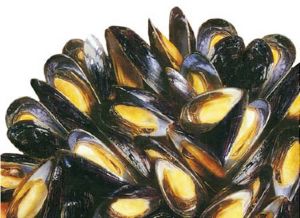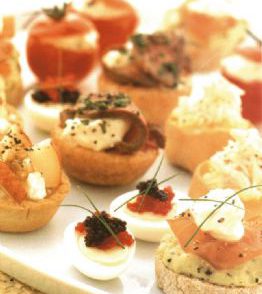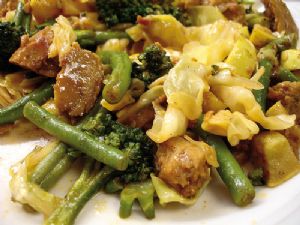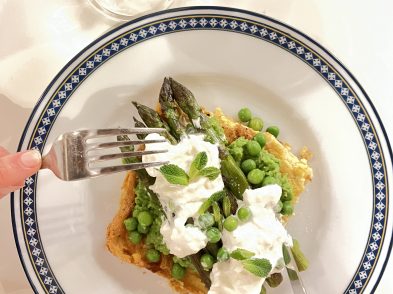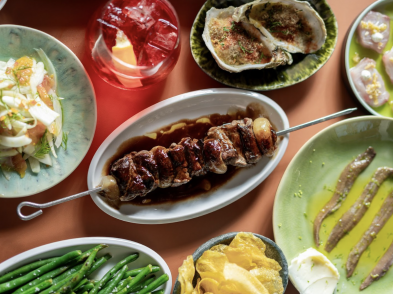Ah, September in Tuscany. Rich colours, lengthening evenings, warmth enough to watch the sunset in short sleeves. Supermarkets overrun with the new influx of international students, working out whether the unidentifiable fish in a jar is for human or feline consumption and struggling to vocalize the Italian word for ‘egg’.
I remember the first time that I set foot in an Italian supermarket. I was working as a food editor, living in London and jaded by the aircraft hangers filled with over-packaged food that passed for supermarkets (A bag filled with pre-chopped onions? Who came up with that bright idea?). Holidaying in Florence, I wandered into a supermarket to get out of the heat-and was gobsmacked. Counters filled with fresh cheese and meat. Exciting pots and dishes of salads, pastes and mixes. Mozzarella. Rabbit. Sausages. Things with tentacles. It was amazing.
Wandering through these altars to niceness can be an over-tempting experience, though. You go in to buy a tin of tuna and leave with a pot of fresh basil, an olive tree, three paper bags filled with in-season fungus and a brace of pheasants-and you still have nothing to put in your sandwich. On a daily basis, this can become quite costly. Furthermore, it can be frustrating to find that the ingredients that you held dear at home are more expensive or completely unavailable here. Fret not. A degree of planning can lead you to adapt and monitor your spending very easily indeed.
The unwary shopper falls into the ‘scale’ trap when buying food in Italy. Peppers and aubergines are of the dimensions that you’d normally expect from a small car: they also perish and each one costs money. Don’t go crazy. Tomatoes can look so tempting, casually tumbling over each other in little red clusters in their boxes. Less so after they’ve been in your fridge, in kilo bags, for a week. Shopping in Italy is a very enjoyable experience, so it’s far better to schedule three short trips to the shop a week than a single huge one, and you’re less likely to end up throwing uneaten food away.
Many supermarkets try to sucker you into buying enormous amounts of meat at a knock-down price-usually if it’s days away from its expiry date. In a hot climate, you can get away with far less than you would in a cooler country. Our advice is to buy large pieces of meat only when it’s unavoidable (for example, if you need to buy a whole chicken for economy) and to consider how much can be frozen and saved. Jointing a piece of meat (such as poultry) is a fairly rewarding and technical endeavour and it’s far cheaper to buy a whole bird than several breast fillets, for example. Stock up on freezer bags and give it a go.
Those amazing things that live in jars may look as if they’re designed to sit in pantries forever, but certain products-like anchovies-perish very quickly, and any jar of food will go off if you remove the food with your fingers or cutlery that has been used for other food but not washed off. Keep the jars refrigerated after opening and lift out the goodies with a clean fork.
Don’t be disheartened if you can’t find your favourite foodstuffs, or if domestically produced items taste somehow different. Italians really, truly know good food. Trust the ingredients that you find and learn to love the variety of tastes and textures. No matter how much you’re pining for favourite brand peanut of butter right now, you’ll be sobbing into your pillow over the fresh fish and vegetables out of reach once you are away from Italy.
INGREDIENT OF THE FORTNIGHT: EGGS
Small. Durable. Cheap. Very, very versatile. Eggs are a cupboard staple and used in many dishes, although it’s easy to ignore them as an ingredient in their own right. They have a uniquely, well, eggy, taste, and it’s this mildly sulphuric flavour and aroma that puts a lot of people off. But they are very nutritious (as long as you don’t eat more than, say, three a week) and their textural oddities make them great to use as ingredients.
Poaching them-cracking them in a shallow pan of simmering water with a drop of vinegar added-is our all-time favourite; serving a poached egg on a slice of toast with some hollandaise sauce takes this dish into a whole new realm. Boiling eggs in their shells, peeling them and serving them with a small heap of celery salt for dipping is also delightful-delicious and extremely simple.
Scrambled eggs are also lovely and can be served with fresh parsley, chopped red pepper and tomato, or smoked salmon stirred into them. Butter is key-melt it in a pan before the eggs are added. If you’re cooking scrambled eggs, and you’re looking into the pan thinking ‘those are almost done’, they are ready; any longer on the heat and they will go rubbery.
Eggs have porous shells and the older they get, the larger the air pocket at the thick end will get. Don’t put them near onions, garlic or strawberries, as they will end up smelling like them. Strawberry eggs sounds intriguing and nice. They aren’t, though.
Recipe:
Poached eggs with hollandaise sauce and spinach
Serves two (sauce contains raw eggs, so pregnant women should not eat it)
6 eggs
200g spinach
50g butter
1 tsp lemon juice
Pinch cayenne pepper
(or similar)
Salt and pepper
White wine vinegar
Four slices of bread (your choice)
1. Put a pan of water on the hob to boil. Put a glass bowl on top of this. Boil the spinach in another pan filled with hot water.
2. Toast the bread.
3. Put another pan (a deep frying pan, ideally) on to boil. Add a couple of drops of vinegar and some salt and pepper.
4. Separate the yolks and whites of two eggs. Mix the yolks well with 1 tbsp of water. Pour this into the glass bowl on top of the boiling pan.
5. Crack the remaining four eggs into the frying pan filled with water. Turn off the heat, and cover the pan. Set to one side.
6. Whisk the egg yolks. Pour in the butter, little by little, whisking all the while. It will thicken and turn lighter in colour. As soon as it’s thickened and pale yellow, remove it from the heat and whisk in 1 tsp of vinegar, salt, pepper, and a pinch of cayenne pepper.
7. Arrange the bread on two plates. Drain the spinach, add salt and pepper, and place this on the toast. Using a slotted spoon, lift the poached eggs out of the water and place on the spinach. Pour the sauce on top of the eggs. Serve.

